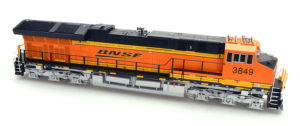All about the community of model railroading and rail enthusiasm
HO SCALE LOCOMOTIVE
Roads include BNSF, Union Pacific, Canadian National, Norfolk Southern, Navajo Mine, CSX
Available in DCC Sound, DCC Non-Sound and DC Non-Sound
DCC Sound $299.95, DCC Non-Sound $219.95
Second release due in 2018
InterMountain Railways first run of ET44AC locomotive has the heft for any operation.
Just picking up InterMountain Railway’s HO-scale Tier 4 GEVO locomotive speaks to its special feel. The General Electric Evolution Series ET44AC can carry its weight.
At 1.6 pounds, the model requires such sensitive handling that InterMountain secures it in packaging by screwing it into a plastic carrier. If this locomotive falls to the floor, it probably won’t bounce.
InterMountain’s ET44AC series, which rolled out last fall, is a reminder of what’s to come when the second release ships, sometime in spring. The models are loaded with detail (the communications cluster on the BNSF unit is impressive), quality painting and plenty of heft like the prototypes.

InterMountain’s first run of ET44AC GEVOs includes BNSF (shown), Canadian National, UP, CSX, Norfolk Southern and Navajo Mine railroads. – InterMountain Railway
The six-axle-powered ET44AC, which replaced the ES44AC, went into production in 2012 with a newer design from previous Tier 4 diesels. The back of the locomotive is distinguishable by a hump that houses the exhaust treatment system, plus the radiator section is larger than previous models.
A Nathan-Airchime model K5HL-R2 “Evolution” air horn is mounted on the hood slightly forward from the chimes on previous models.
The locomotives are workhorses at 4,365 tractive horsepower and feature a 5,300-gallon fuel tank and GEVO 12 engine.
Most of GE’s Evolution Series locomotives are manufactured in Fort Worth. Many can be seen on UP, CSX, Norfolk Southern and Canadian National railroads with features specific to each road.
UP employs the largest livery of ET44AH (C45AH) units at 200, numbered 2570-2769, next to CSX and Canadian National. BNSF ordered the similar ET44C4 locomotives, which have four powered and two idled axles compared to the ET44AC. BNSF has 389 units, numbered 3725-3999, 4200-4299 and 5533-5546.
At Trainfest in November, InterMountain had samples of the inaugural ET44AC series run, which includes BNSF, Canadian National, UP, CSX, Norfolk Southern and Navajo Mine railroads. The company is re-releasing the same roads, which come in six road numbers (NMR has two) in DCC w/sound and DCC without sound.
On our UP and BNSF samples, the laser-printed paint was as sharp as billed and the units had plenty of gusto. At a demonstration in December at the Texas Western Model Railroad Club, each pulled 32 ore cars effortlessly, starting and stopping just like the prototype.
The molded detail on the angled exhaust housing – available on BNSF, CN, CSX and UP models – is intoxicating. So, too, are the spinning bearing caps on the well-detailed truck sets and brake chains.
The factory-equipped ESU LokSound Select Sound decoder provides quality diesel sound and other functions from the sugar-cube speakers. In all, 24 sound and light functions are available on DCC models (only lights are available on non-sound models), and each worked well.
To get the locomotive rolling, press the F8 function key before throttling. This starts the prime mover and simulates start-up. After about 25 seconds, the prime mover idles rapidly and is ready for a speed command. With no movement after 10-15 seconds, the prime mover will settle into idling until the throttle is advanced. Pressing F8 again powers down the unit.
The model also features Drive Hold, which allows for throttling the prime mover sound up or down while the locomotive keeps a steady speed. This simulates maintaining speed while decreasing the throttle on flat or downhill advances or upping the prime mover on grades.
A unique feature is blowing the horn when the locomotive isn’t idling, just like on the prototype as long as air is available.
The model is ready to run with the exception of applying the window shades.
Removing the shell takes a little work and careful handling. The front and rear coupler boxes must be unscrewed and should be kept intact for reassembly. Also, tweezers are need to remove the brake chain on the rear truck (BNSF units have three chains). InterMountain provides detailed instructions for shell removal and assembly in a four-page operator’s guide included with the model.
Considering the level of detail and performance, this model is well worth its $299.95 sound price tag.
InterMountain’s ET44AC is yet another quality entry into today’s model railroad locomotive market. Realistic painting, molding and functions add to the realism available from manufacturers.
The model fits right in to any modern-day operations.